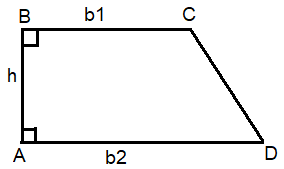PRACTICE PROBLEMS ON SAT
Problem 1 :
The radius of a circle is increased by 25%. By what percent does the area of the circle increase ?
Solution :
Let r be the radius of the circle.
Radius will increase 25% of the original.
Area of circle = πr2
Let old radius = r
New radius = r + 25% of r
= r + (25/100) r
= r + (1/4)r
= 5r/4
Problem 2 :
The length of a rectangle increased by 20%. The width is decreased by 20%. Which of the following accurately describes the change in area of the following ?
(a) Increases by 10% (b) Decreases by 10%
(c) Decreases by 4% (d) Stays the same
Solution :
Let l and w be the length and width of rectangle respectively.
Area of rectangle = l x w
Length of the rectangle increased by 20%.
New length = 1.20l
New width = 0.80w
Area of new rectangle = 1.20l(0.80w)
= 1.20(0.80) lw
= 0.96 lw
= (96/100) lw
= 96 % of lw
area of new rectangle = 96% of old rectangle.
So, decrease of 4%.
Problem 3 :
F = 9q1 q2/r2
The force of attraction between two particles can be determined by the formula above, in which F is the force between them, r is the distance between them and q1 and q2 are charges of the two particles.
If the distance between two charged particles is doubled, the resulting force of attraction is what fraction of the original force ?
(a) 1/2 (b) 1/4 (c) 1/8 (d) 1/16
Solution :
New r = 2r
New force (F) = 9q1 q2/(2r)2
= 9q1 q2/4r2
= (1/4) (9q1 q2/r2)
So, the answer is 1/4.
Problem 4 :
P = V2/R
Electric power P is related to the voltage V and resistance R by the formula above. If the voltage were halved, how would the electric power be affected ?
(a) The electric power would be 4 times greater
(b) The elevtric power would be 2 times greater
(c) The electric power would be halved
(d) The electric power would be quarter of what it was.
Solution :
P = V2/R
Voltage were halved, then new V = 1/2V
P = ((1/2)V)2/R
P = ((1/4)V)2/R
The electric power would be quarter of what it was.
Problem 5 :
Julie has a square fence that encloses her garden. She decides to expand her garden by making each side of the fence 10% longer. After this expansion, the area of Julie's garden will have increased by what percent ?
(a) 20% (b) 21% (c) 22% (d) 25%
Solution :
Let x be the side length of garden.
Side length of new square = 110% of x
Area of square = (110% of x)2
= 1.21x2
Percentage increase = [(1.21x2 - x2)/x2] • 100%
= (1.21 - 1) • 100%
= 0.21 • 100%
= 21%
Problem 6 :
A right circular cone has a base radius of r and a height of h. If the radius is decreased by 20% and height is increased by 10%, which of the following is the resulting percent change in the volume of cone ?
(a) 10% decrease (b) 12% decrease
(c) 18.4% decrease (d) 29.6% decrease
Solution :
Volume of cone = πr2h
New radius = 80% of r
New height = 110% of h
Volume of new cone = π(0.80r)2(1.10h)
= 0.704πr2h
Percentage change = [(0.704πr2h - πr2h)/πr2h] • 100%
= [(0.704 - 1)πr2h)/πr2h] • 100%
= -0.296 • 100%
= -29.6 %
So, the answer is 29.6 % decrease.
Problem 7 :

The area of the trapezoid above can be found using the formula (1/2)h(b1+b2). If lengths of BC and AD are halved and height is doubled, how would the area of the trapezoid change ?
(a) The are would be increased by 50%
(b) The area would stay the same
(c) The area would be decreased by 25%
(d) The area would be decreased by 50%
Solution :
BC = b1, New BC = b1/2
AD = b2, New AD = b2/2
AB = h, New AB = 2h
Applying the values that we have received newly in the formula,
(1/2)h(b1 + b2)
we get,
= (1/2)(2h)(b1/2 + b2/2)
= h(b1/2 + b2/2)
= (1/2)h(b1+ b2)
The area would stay same.
Problem 8 :
Calvin has a sphere that is four times bigger than the one Kevin has in terms of volume. The radius of Calvin's sphere is how many times greater in length than the radius of Kevin's sphere (rounded to the nearest hundredth)
(a) 1.44 (b) 1.59 (c) 1.67 (d) 2.00
Solution :
Volume of sphere = (4/3)πr3
Let R be radius of Calvin's sphere and r be the radius of Kevin's sphere.
(4/3)πR3 = 4(4/3)πr3
(4/3)πR3 = 4(4/3)πr3
R3 = 4r3
R = 3√4r3
R = r (3√4)
Cube root of 4 is 1.59
R = 1.59 r
Problem 9 :
If a number p increased by 120 percent equals a number q decreased by 20 percent, which of the following is true?
(a) q = (5/2)p (b) q = (11/4)p
(c) q = (7/2)p (d) q = (15/4)p
Solution :
|
p increased by 120% New p : = p + 120% of p = 220% of p |
q decreased by 20% New q : = q - 20% of q = 80% of q |
220% of p = 80% of q
220p = 80q
22p = 8q
11p = 4q
q = (11/4)p
Recent Articles
-
Finding Range of Values Inequality Problems
May 21, 24 08:51 PM
Finding Range of Values Inequality Problems -
Solving Two Step Inequality Word Problems
May 21, 24 08:51 AM
Solving Two Step Inequality Word Problems -
Exponential Function Context and Data Modeling
May 20, 24 10:45 PM
Exponential Function Context and Data Modeling